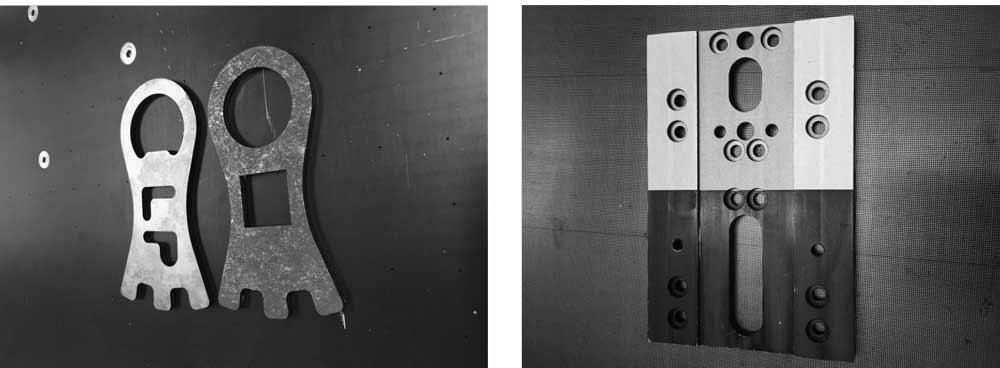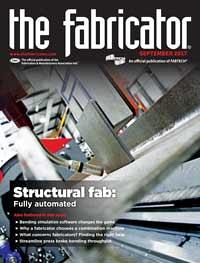Editor-in-Chief
- FMA
- The Fabricator
- FABTECH
- Canadian Metalworking
Categories
- Additive Manufacturing
- Aluminum Welding
- Arc Welding
- Assembly and Joining
- Automation and Robotics
- Bending and Forming
- Consumables
- Cutting and Weld Prep
- Electric Vehicles
- En Español
- Finishing
- Hydroforming
- Laser Cutting
- Laser Welding
- Machining
- Manufacturing Software
- Materials Handling
- Metals/Materials
- Oxyfuel Cutting
- Plasma Cutting
- Power Tools
- Punching and Other Holemaking
- Roll Forming
- Safety
- Sawing
- Shearing
- Shop Management
- Testing and Measuring
- Tube and Pipe Fabrication
- Tube and Pipe Production
- Waterjet Cutting
Industry Directory
Webcasts
Podcasts
FAB 40
Advertise
Subscribe
Account Login
Search
Cleaning metal surfaces with a laser
Fiber laser technology is not just for cutting and marking
- By Dan Davis
- October 7, 2017
- Article
- Laser Cutting

Figure 1
A fiber laser was used to clean the surface of these metal parts to prepare them for downstream processing.
The phrase “cleaning metal surfaces” might mean different things to different metal fabricators, but in the end, all know it’s a big deal.
Metal fabricators that have painting and powder coating lines have to deal with the headaches of large pretreatment systems that require intense oversight to ensure the chemicals create a surface to which the paint or powder can properly adhere. Other fabricators might have to worry about preparing metal surfaces for welding, which requires the right power tool, abrasive, and a lot of elbow grease. Some shops might have to degrease metal or remove anodized surfaces prior to further processing. All of these fabricators know that resources and expertise are needed to obtain the clean surface necessary for the next step in the fabrication process.
Laser Photonics™, an Orlando, Fla.-based brand that specializes in laser-based R&D and machinery development, hopes to change the way that fabricators look at surface cleaning. It has launched its CleanTech™ product line for applications such as surface conditioning of metal for better adhesion and weld preparation (see Figure 1).
The CleanTech laser systems remove coatings, contaminants, and residues with the use of high-energy fiber laser sources, the same type of power source found in the company’s laser cutting and marking systems. The actual power of the laser power source is dependent on the application, but it can reach the kilowatt range if necessary.
“By further expanding our line of laser material processing systems, Laser Photonics creates opportunity not only for the industrial giants but also for small manufacturers to take advantage of the most advanced industrial-grade Class 1 laser cleaning and surface treatment equipment available,” said Dmitriy Nikitin, CEO.
The process is meant to replace the use of chemicals and abrasives to clean these metal surfaces. The fabricator places the part to be cleaned in the Class 1 enclosure and initiates a cleaning program. The equipment operator can choose to use a preinstalled cleaning pattern or develop a custom pattern to meet a certain surface specification or throughput requirement. The operator can also adjust a program to include multiple passes using different values for power, frequency, and speed on each laser pass. A database can store thousands of different cleaning jobs so that the operator doesn’t have to remember a cleaning job that was done previously.
The laser can be used to clean a variety of metals, including steel, aluminum, stainless steel, and galvanized. It can even work with reflective metals, such as brass and copper, and nonmetallic materials, such as plastics and rubber.
This laser cleaning capability is not limited to flat surfaces, according to company officials. Most laser systems have statically positioned cleaning heads, which limits the laser cleaning ability to only the static path of the trajectory beam. It’s similar to a noon-time sun’s rays hitting an object directly over the top and not making contact with other areas hidden from the sun’s 90-degree positioning over the object. CleanTech stationary cleaning units are designed to clean those areas on 3-D objects that are hard to reach.
Nikitin said the company’s Flexion™ system moves a stage, on which the parts sit, in both the X and Y axis inside the cleaning chamber. The movement ensures the parts are fully exposed to the laser beam’s trajectory.
This laser cleaning technology is not limited to a stand-alone, midsized unit. It is available in a handheld unit where the metal surface acts as the bottom of the laser chamber. A laser removes the contaminants as the operator runs the hand held unit over the metal surface. This type of a device can have a working envelope up to 4 by 4 inches.
The laser cleaning technology also can be found on the company’s Titan flatbed platform, which can be as large as 6 by 13 feet. The large space can be used to clean objects such as multiple tire rims, large flanges used in the oil and gas industry, or even a sheet used for hull construction in shipbuilding.
The stationary parts can be designed to be part of a production line. An integrated dust and residue collection system can be incorporated as well to minimize manual cleaning.
Laser Photonics, 407-804-1000, www.laserphotonics.com
About the Author

Dan Davis
2135 Point Blvd.
Elgin, IL 60123
815-227-8281
Dan Davis is editor-in-chief of The Fabricator, the industry's most widely circulated metal fabricating magazine, and its sister publications, The Tube & Pipe Journal and The Welder. He has been with the publications since April 2002.
subscribe now

The Fabricator is North America's leading magazine for the metal forming and fabricating industry. The magazine delivers the news, technical articles, and case histories that enable fabricators to do their jobs more efficiently. The Fabricator has served the industry since 1970.
start your free subscription- Stay connected from anywhere

Easily access valuable industry resources now with full access to the digital edition of The Fabricator.

Easily access valuable industry resources now with full access to the digital edition of The Welder.

Easily access valuable industry resources now with full access to the digital edition of The Tube and Pipe Journal.
- Podcasting
- Podcast:
- The Fabricator Podcast
- Published:
- 04/16/2024
- Running Time:
- 63:29
In this episode of The Fabricator Podcast, Caleb Chamberlain, co-founder and CEO of OSH Cut, discusses his company’s...
- Trending Articles
Tips for creating sheet metal tubes with perforations

JM Steel triples capacity for solar energy projects at Pennsylvania facility

Are two heads better than one in fiber laser cutting?

Supporting the metal fabricating industry through FMA

Omco Solar opens second Alabama manufacturing facility

- Industry Events
16th Annual Safety Conference
- April 30 - May 1, 2024
- Elgin,
Pipe and Tube Conference
- May 21 - 22, 2024
- Omaha, NE
World-Class Roll Forming Workshop
- June 5 - 6, 2024
- Louisville, KY
Advanced Laser Application Workshop
- June 25 - 27, 2024
- Novi, MI


























